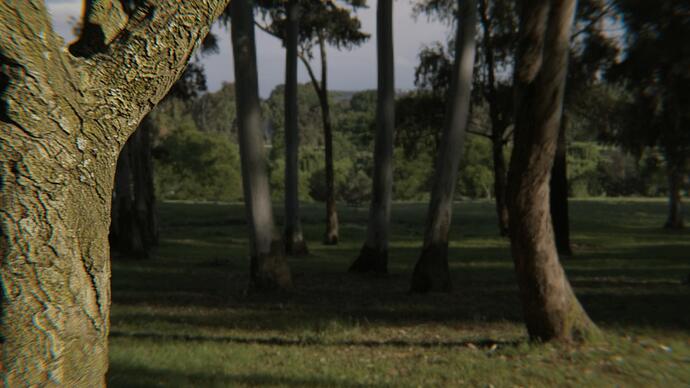Im trying to make a photorealistic tree. More specifically, a Yoshino cherry blossom tree trunk. Before asking this question, I tried make a bit of research on photorealism.
My question is: What it takes to make a photorealistic tree and what is left in my case?
Even though I thought I followed every step to achieve photorealism it still looks like this :
I only modeled the tree that’s obviously 3D, the front tree. The rest is part of the HDRI map.
The steps I followed were :
-
Modelling
-
Materials
-
Lighting
-
Post-processing
- Modelling (Why I think it’s all done at this)
- It’s all in real world scale, this tree on the project has 12 meters of height and 15 meters of spread. (Oh, if you don’t see 12 meters of height and 15 meters of spread, it’s because the camera angle is not taking the whole tree, but you can see down below the model)(https://i.stack.imgur.com/FLHjd.png)
- No sharp edges!
- I used a reference, this image down below.(https://i.stack.imgur.com/kTr8Q.jpg)
- Anatomy - I’m not a pro on human body anatomy, but I must say that when doing this tree, I matched almost the exact same image, and since it’s a tree, it does not need to be 100% equal to be still a tree, because they have different shapes and grow in random ways. So “I THINK”, it may be right.
- Textures (Why I think it’s all done at this)
- I use PBR Maps from Quixel Megascans, that have :
- Albedo
- Ambient Occlusion
- Cavity
- Roughness and Gloss (The maps are opposite to each other)
- Bump Map
- Displacement
- Normal Map
- Specular
All of these are included in the final result, so, I think it’s right, I guess, right?
Obs : The texture of the wood on the image comparisons are different, but what I want, is for it to look like a photorealistic of wood, even if it’s different.
- Surface imperfections : Bump map and displacement does that for us, right?
- Use Physically accurate renderers/shaders :
Ok, maybe I’m too old, but as far as I know, the basic node structure for rendering in cycles does not offer Physically accurate shader calculations, maybe I’m just saying things I don’t know that I saw on a youtube video, I COULD BE WRONG, but let’s proceed from this. I, myself, use cycles. And I started thinking, “Well, maybe that’s where I ***ked up, cycles it’s imperfect, so let’s go for another one”, that’s when I stumbled on a video from a guy saying That your render engine isn’t that important as you may think, and most of the work that you do, can be done using the base engine you have. And I started to realize, maybe that’s true, because seeing some render engines comparisons, They looked almost the same, with little small details of difference. So I started to neglect this point of the structure. If I did it wrong, please, tell me.
- Lighting (Why I think it’s all done)
- Use real-world light direction :I use HDRI maps, it’s already included in that.
- Use the correct color of light :As I said, I use HDRI maps, it’s already included in that.
- Use the right reflections :As I said, I use HDRI maps, it’s already included in that.
Extra Obs : I know it may look like I could be looking for more in case of lighting, but when I start thinking about the HDRI maps, they literally take how the light affects the real world, what would be left?
- Post processing (Why I think it’s all done) :
- Glare : It’s has a little bit of it.
- Motion Blur : Not necessary, I don’t want the feeling of movement.
- Depth of field : Yes, there’s!
- Chromatic Aberration : Yes, I added a little bit to it!
- Barrel Distortion : Yes, there’s distortion on the image!
So, folks, what’s left? Where did I get wrong? If possible, I just want to know what’s left, what should do make this image better looking.
